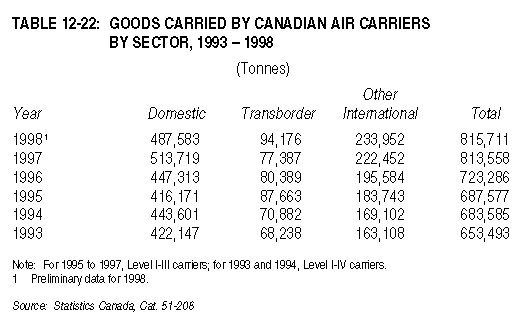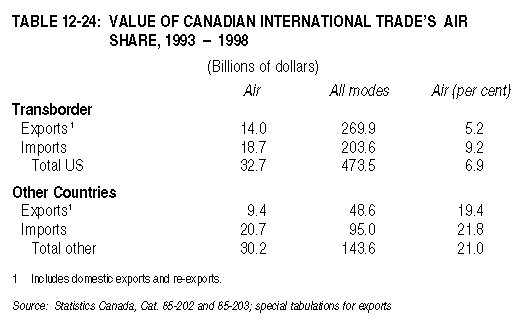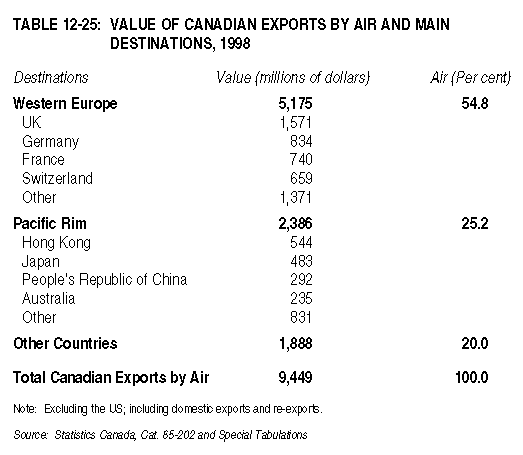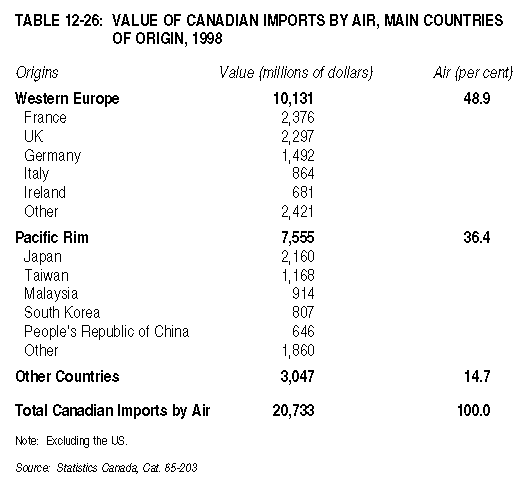12
FREIGHT
TRANSPORTATION
Air Transportation Industry
Air Cargo
Domestic air cargo transportation is provided within a deregulated
environment that does not restrict routing, capacity or pricing.
Cargo is carried in the belly-hold of passenger aircraft, on passenger/cargo
combination aircraft and in dedicated cargo aircraft. Scheduled
and non-scheduled (charter) transborder and international air cargo
service is provided within a framework of bilateral air agreements,
international agreements and national policies. It is the prerogative
of the Minister of Transport to designate the Canadian carriers
that will exercise the international all-cargo rights for scheduled
services, which have been acquired by Canada through bilateral negotiations.
Cargo revenues represent a small proportion of the total revenues
of Canada's two major carriers. For Air Canada and Canadian Airlines,
cargo revenues accounted for only 7.7 per cent of their combined
1998 total unconsolidated revenues of $7.6 billion. Most of the
cargo revenue for the major carriers is earned on cargo carried
on passenger flights. Air Canada operates four passenger/cargo
combination aircraft across the Atlantic. Cargo revenues are of
less importance to the regional carriers that fly smaller aircraft
because they have less cargo capacity. There is a large group
of smaller carriers, most of which fly small cargo aircraft,
that provide cargo services on a charter basis throughout
the country. These carriers play a particularly important
role in transporting cargo in the North.
Although specific information on Canada is not available, forecasts
for the global air cargo market predict continued growth for the
industry. Airframe manufacturers predict that air freight traffic
will grow at an annual average rate of six percent over the next
20 years. The role of international express services is also
expected to increase during the same period.
Domestic Services
The domestic air cargo industry includes passenger air carriers
that carry cargo in their aircraft belly-hold for incremental
revenue; all-cargo carriers; and freight forwarders and consolidators
of shipments.
Table 12-22 shows the volume of goods carried by Canadian air
carriers, by sector, from 1993 to 1998. There was very little
change in the total tonnes of cargo carried between 1997 and 1998.
Domestic tonnes carried dropped by five per cent to 487,583 tonnes,
and accounted for 60 per cent of the total tonnes carried
in 1998. During the same period, transborder tonnes carried
increased by 22 per cent, while international tonnes carried
rose by five per cent.

Table 12-23 shows the operating revenues generated by goods
carried on Canadian air carrier services, by sector, from 1993
to 1998. Total cargo operating revenues increased by eight per
cent between 1997 and 1998. Domestic revenues accounted for 67
per cent of total cargo operating revenues in 1998. Domestic revenues
increased by eight per cent between 1997 and 1998, reaching
$768 million, while international revenues increased by seven
per cent.

Air cargo carriers provide a vital transportation service in
the North, where alternative transportation is often not available.
Large aircraft operators, such as First Air and Canadian North,
provide services that link northern communities to each other
and to major centres in southern Canada. In addition, numerous
small cargo carriers provide service in Canada's northern regions.
Preliminary data for cargo activity in the North indicate that
major carriers carried four per cent more domestic cargo in 1998
than in 1997. There is no data available on activity by regional
and local cargo carriers, as they are not required to file cargo
carriage data.
Canada-U.S. Transborder Services
In 1998, air transport between Canada and the US amounted to
$32.7 billion, or close to seven per cent of the total $473.5
billion transborder trade (see Table 12-24). Of this, $18.7 billion
were imports and $14 billion were exports. The top import commodities
were telecommunications equipment ($3.8 billion), electronic equipment
($3.3 billion), aircraft equipment ($3.0 billion), machinery/equipment
($2.7 billion) and medical supplies ($1.2 billion). The top export
commodities were aircraft equipment ($4.3 billion), office machine
equipment ($2.7 billion), telecommunications equipment ($2.2
billion) and other equipment/tools ($1.2 billion). It should be
noted that a significant portion of cargo moving on air waybills
is actually trucked between Canada and the US, but is recorded
in trade data as air traffic.

Many Canadian all-cargo operators provide transborder cargo
services under contract to the major courier companies. Table
11-15 in the previous chapter shows the participation
of Canadian air carriers in transborder courier operations.
Other International Services
In 1998, air transport between Canada and countries other than
the US amounted to $30.2 billion, or 21 per cent of Canada's $143.6
billion in this trade category. Of the total carried by air, $20.7
billion was accounted for by imports and $9.4 billion was accounted
for by exports. Ontario and Quebec dominated air transport trade
with other countries, with 43 per cent and 25 per cent, respectively.
Table 12-25 shows that the main non-US destinations for Canada's
exports by air were Western European countries, with $5.2 billion
in exports, and Pacific Rim countries, with $2.4 billion. Imports
by air from non-US countries also originated mainly in Western
Europe, with $10.1 billion, and the Pacific Rim, with $7.6 billion.
Table 12-25 also shows the value of Canadian exports by air,
by main destination, for 1998. Table 12-26 shows the value of
Canadian imports by air, by main countries of origin, for 1998.


Five major international cargo carriers provided regularly
scheduled all-cargo air service to and from Canada during 1999:
Cathay Pacific (Vancouver), Korean Air (Toronto), Air France (Montreal),
Lufthansa Cargo (Montreal) and Iberia (Montreal). In addition
to these, there were carriers operating non-scheduled, or charter,
cargo flights from international points to Canada.
Air Transportation Industry
|

